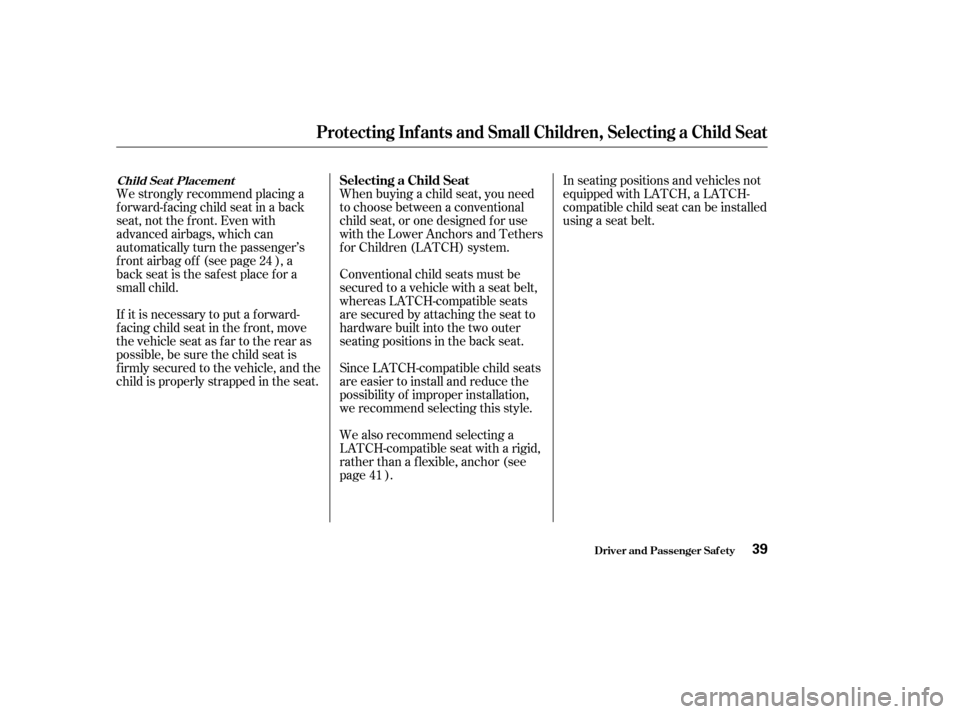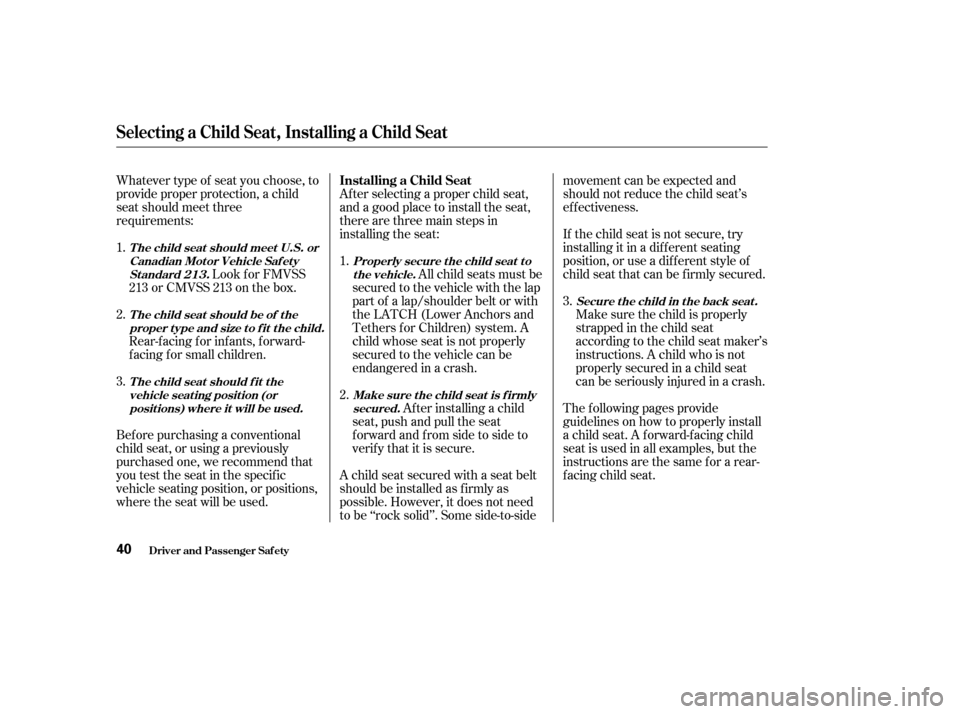Page 38 of 313

We strongly recommend placing a
forward-facing child seat in a back
seat,notthefront.Evenwith
advanced airbags, which can
automatically turn the passenger’s
front airbag off (see page ), a
back seat is the safest place for a
small child.
If it is necessary to put a f orward-
f acing child seat in the f ront, move
the vehicle seat as far to the rear as
possible, be sure the child seat is
f irmly secured to the vehicle, and the
child is properly strapped in the seat.When buying a child seat, you need
to choose between a conventional
child seat, or one designed f or use
with the Lower Anchors and Tethers
f or Children (LATCH) system.
Conventional child seats must be
secured to a vehicle with a seat belt,
whereas LATCH-compatible seats
are secured by attaching the seat to
hardware built into the two outer
seating positions in the back seat.
Since LATCH-compatible child seats
are easier to install and reduce the
possibility of improper installation,
we recommend selecting this style.
We also recommend selecting a
LATCH-compatible seat with a rigid,
rather than a f lexible, anchor (see
page ).In seating positions and vehicles not
equipped with LATCH, a LATCH-
compatible child seat can be installed
using a seat belt.
24
41
Protecting Inf ants and Small Children, Selecting a Child Seat
Driver and Passenger Saf ety
Child Seat PlacementSelecting a Child Seat
39
�����—�����—�����y�
���������
���y���
�(���%���
���y���������y
Page 39 of 313

Whatever type of seat you choose, to
provide proper protection, a child
seat should meet three
requirements:Look f or FMVSS
213 or CMVSS 213 on the box.
Rear-facing for infants, forward-
f acing f or small children. Af ter selecting a proper child seat,
and a good place to install the seat,
there are three main steps in
installing the seat:
All child seats must be
secured to the vehicle with the lap
part of a lap/shoulder belt or with
the LATCH (Lower Anchors and
Tethers f or Children) system. A
child whose seat is not properly
secured to the vehicle can be
endangered in a crash.
Af ter installing a child
seat, push and pull the seat
f orward and f rom side to side to
verif y that it is secure.
A child seat secured with a seat belt
should be installed as f irmly as
possible. However, it does not need
to be ‘‘rock solid’’. Some side-to-side movement can be expected and
should not reduce the child seat’s
ef f ectiveness.
If the child seat is not secure, try
installing it in a dif f erent seating
position, or use a dif f erent style of
child seat that can be f irmly secured.
Make sure the child is properly
strappedinthechildseat
according to the child seat maker’s
instructions. A child who is not
properly secured in a child seat
can be seriously injured in a crash.
The f ollowing pages provide
guidelines on how to properly install
a child seat. A f orward-f acing child
seat is used in all examples, but the
instructions are the same f or a rear-
f acing child seat.
Bef ore purchasing a conventional
child seat, or using a previously
purchased one, we recommend that
you test the seat in the specif ic
vehicle seating position, or positions,
where the seat will be used.
1. 2.3.
1. 2.
3.
Selecting a Child Seat, Installing a Child Seat
Driver and Passenger Saf ety
T he child seat should meet U.S. or
Canadian Mot or Vehicle Saf et ySt andard 213.
T he child seat should be of theproper t ype and size t o f it t he child.
T he child seat should f it thevehicle seat ing posit ion (or posit ions) where it will be used. Properly secure t he child seat t o
the vehicle.
Make sure t he child seat is f irmlysecured. Secure the child in the back seat.
Installing a Child Seat
40
�����—�����—�����y�
�������������y���
�(���%���
���y���������y
Page 40 of 313
CONT INUED
Your vehicle is equipped with
LATCH (Lower Anchors and
Tethers for Children) at the outer
rear seats. The lower anchors are
located between the seat-back and
seat bottom, and are to be used only
with a child seat designed f or use
with LATCH.Some LATCH-compatible seats have
a rigid-type connection as shown
above.Place the child seat on the vehicle
seat, and attach the seat to the
lower anchors according to the
child seat maker’s instructions.
The location of each lower anchor is
marked with a small illustrated circle
above the point.
To install a LATCH-compatible child
seat:
Move the seat belt buckle or
center seat belt away from the
lower anchors.
Make sure there are no objects
near the anchors that could
prevent a secure connection
between the child seat and
anchors.
1. 2.
3.
Installing a Child Seat
Driver and Passenger Saf ety
Installing a Child Seat with
LATCH
41
LOWERANCHORMARKS Rigid type
�����—�����—�����y�
�������������y���
�(���%���
���y���������y
Page 41 of 313
Other LATCH-compatible seats have
a f lexible-type connection as shown
above.Whatever type you have, f ollow
the child seat maker’s instructions
f or adjusting or tightening the f it. Route the tether strap through the
legs of the head restraint, then
attach the hook to the anchorage
point as shown.
Make sure the strap is not twisted,
then tighten the strap according to
the child seat maker’s instructions.
Push and pull the child seat
f orward and f rom side-to-side to
verif y that it is secure.
4. 5.
6. 7.
Installing a Child Seat
Driver and Passenger Saf ety42
Flexible type
�����—�����—�����y�
�����������
�y���
�(���%���
���y���������y
Page 42 of 313

CONT INUED
When not using the LATCH system,
all child seats must be secured to the
vehicle with the lap part of a lap/
shoulder belt.
In addition, the lap/shoulder belts in
the rear seat and the f ront passenger
seat have a locking mechanism that
must be activated to secure a child
seat.With the child seat in the desired
seating position, route the belt
through the child seat according
to the seat maker’s instructions,
then insert the latch plate into the
buckle.To activate the lockable retractor,
slowly pull the shoulder part of the
belt all the way out until it stops,
then let the belt f eed back into the
retractor.
Af ter the belt has retracted, tug on
it. If the belt is locked, you will not
be able to pull it out. If you can pull
thebeltout,itisnotlocked,and
you will need to repeat these steps.
1.
2. 3.
Installing a Child Seat
Driver and Passenger Saf ety
Installing a Child Seat with a L ap/
Shoulder Belt
43
�����—�����—�����y�
�������������y���
�(���%���
���y���������y
Page 43 of 313
To deactivate the locking
mechanism and remove a child seat,
unlatch the buckle, unroute the seat
belt, and let the belt f ully retract.
Push and pull the child seat
f orward and f rom side to side to
verif y that it is f irmly secured. If
the child seat is not secure,
unlatch the belt, allow it to retract
f ully, then repeat these steps.
Af ter conf irming that the belt is
locked, grab the shoulder part of
the belt near the buckle and pull
up to remove any slack from the
lap part of the belt. Remember, if
the lap part of the belt is not tight,
the child seat will not be secure.
To remove slack, it may help to
putweightonthechildseat,or
push on the back of the seat while
pulling up on the belt. 5.
4.
Installing a Child Seat
Driver and Passenger Saf ety44
�����—�����—�����y�
���������
�
�y���
�(���%���
���y���������y
Page 44 of 313
CONT INUED
Since a tether can provide additional
security to the lap/shoulder belt
installation, we recommend using a
tether whenever one is required or
available. (Tethers are required in
Canada.)
A child seat with a tether can be
installed in any seating position in
the back seat, using one of the
anchorage points shown above.
Lif t the anchor point lid, then
attach the tether strap hook to the
anchor, making sure the strap is
not twisted.
Tighten the strap according to the
seat maker’s instructions.
Af ter securing the child seat in the
desired position (see page ), lif t
the head restraint, then route the
tether strap over the top of the
seat-back and through the head
restraint legs.
1.
2. 3.
43
Installing a Child Seat
Driver and Passenger Saf ety
Installing a Child Seat with a
TetherUsing an Out er A nchorage Point
45
COVER
TETHER ANCHORAGE P OINTS ANCHOR
TETHER
STRAP
HOOK
�����—�����—�����y�
�������������y���
�(���%���
���y���������y
Page 45 of 313
Af ter properly securing the child
seat (see page ), route the
tether strap over the top of the
seat-back.
Attach the tether strap hook to the
anchor, making sure the strap is
not twisted, then tighten the strap
according to the seat-maker’s
instructions.
1. 2.
43
Installing a Child Seat
Driver and Passenger Saf ety
Using t he Cent er A nchorage Point
46
TETHER STRAP HOOK
TETHER ANCHORAGE P OINT
�����—�����—�����y�
�������������y���
�(���%���
���y���������y